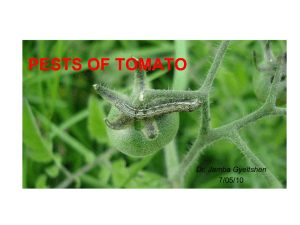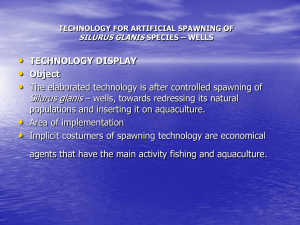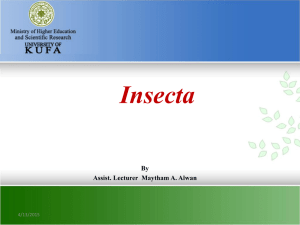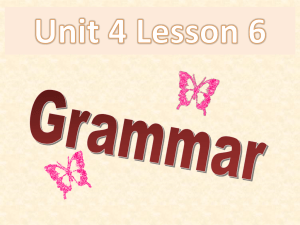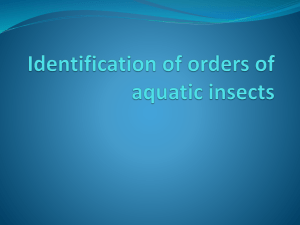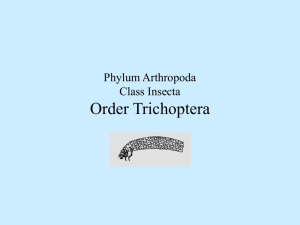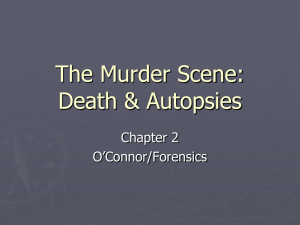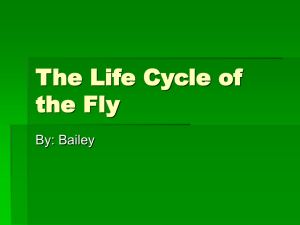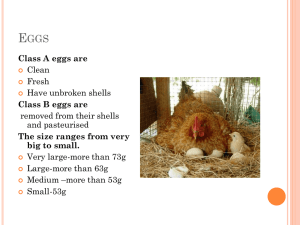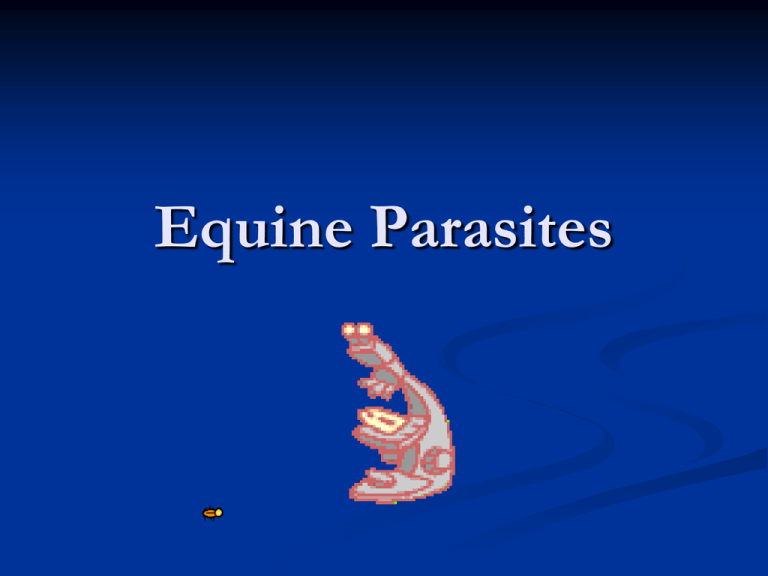
Equine Parasites
General Considerations
Parasites are most successfully prevented
through a combination of management and
therapeutic strategies
Management
Decrease parasite burden in environment
Therapeutic
Deworming with proper product at proper
intervals
Parasite Prevention
Adequate pasture acreage
Compost manure
Cleanliness
Pasture rotation
Mixed grazing (cattle and horses)
Pasture Rotation
Infective larvae on pasture decreases greatly over the
winter and also in hot, humid days of summer
Move horses from old, infested pastures to ones that
have minimal numbers of infective larvae
Deworm prior to moving
Foals and young horses should go to cleanest available
pastures
Internal parasites
1.
2.
3.
The amount of clinical disease a horse will
show depends on three factors:
Type of parasite involved
Number of parasites involved
Host defenses. Young and debilitated animals
more susceptible
Life Cycle of Parasites
Eggs
Larvae (immature worms)
Adults (mature worms)
Life cycle of the parasite
Eggs or larvae are deposited on
the ground in the manure of
infected horse
The eggs and larvae develop in the
environment and are swallowed
while the horse is grazing
Larvae mature in the horse’s
digestive tract where most of them
become egg laying adults.
Internal parasites – Common
signs
Poor growth
Weight loss
Decreased feed
efficiency
Colic
Diarrhea
Pneumonia
Death
Dull hair coat
Clinical sign – colic
Poor performance
Important Parasites in the horse
Large strongyle (Stongylus vulgaris, S.edentatus,
S.equinus)
Small strongyle (Cyathostemes)
Round worm (Ascarids)
Bots (Gastrophilus spp)
Pin worms (Oxyuris equi)
Tapeworms (Anoplochephala)
Threadworm (Strongyloides)
Large Strongyle
Strongylus vulgaris
Blood worm- bloodsucking of the large
instestine
Most dangerous parasite of horses
Causes thromboembolic colic, various degrees
of anemia.
Direct life cycle
Larvae live in artery supplying blood to the
intestines. Blood clots form which block blood
supply to the intestine
First stage is the egg in feces or soil, molts to 2nd
stage in feces or soil. 3rd stage becomes
“sheathed” or sticks to walls, buckets, etc.
When ingested by the horse the infective 3rd
stage larvae of S.vulgaris cast off there sheath in
the lumen of the s. intestine and enter the wall
of the cecum and ventral colon. They curl up
under the mucous membrane and prepare to
molt. After 8 days the molt is complete and
become a 4th stage larva and resume migration.
4th stage penetrate nearby small arterioles and
wanders to the cranial mesenteric artery, which
supplies blood to the instestine. (this leaves a
path of inflammation, which can lead to
thrombosis or occlude the vessel) After 2-4
months they enter the surrounding tissue of the
intestinal wall and a final molt takes place and
the immature adults (5th stage) enter the lumen
of the cecum and ventral colon , mature and
reproduce 6 months after original ingestion
Collateral circulation
Life Cycle
Adult large strongyle
Strongylus vulgaris,adults in equine
intestine “bloodworms”
After deworming “red worms”
This verminous arteritis
lesion is from the cranial
mesenteric artery of a
weanling Quarter Horse
colt. Verminous arteritis
is caused by the
migration of larvae of
Strongylus vulgaris
through the blood
vessels. It was once a
common cause of colic
and death in domestic
horses.
S.edentatus, S. equinus
2 times as large as adults
The 3rd stage of S. edentatus migrate to the liver,
become encapsulated and molt to the 4th stage in
approx. 2 weeks. After molting the larvae
wander aimlessly in the liver for 2 months, leave
the liver by ligaments that hold the liver in
position, wander for months in the connective
tissues, and 11 months (PPP) after ingestion can
be found in the lining of the cecum and colon.
3rd stage S.equinus encyst and undergo molt in
the wall of the large intestine. After molting
they bore into the right half of the liver which
lies in contact with this portion of the large
intestine. They stay for 6-7 weeks, enter the
pancreas and abdominal cavity where the
complete their development to adults. Reenter
the lumen of the large intestine and mate. (9mo.
PPP)
Large and small strongyle
Diagnosis
Diagnosis of mixed strongyle infection is based
on demonstration of eggs in the feces. Specific
diagnosis can be made by identifying the
infective larvae after fecal
Large Strongyles
Treat every 6 months
Use Ivermectin or monoxidecin
Small Strongyle- Cyathostominae
Numerous species of strongyles
(40)
Direct Life cycle
Larvae life in gut wall of large
intestine- therefore not as
pathogenic as large stongyle
Cause damage to gut wall
resulting in G.I. upset, and
severe diarrhea.
Internal parasites of highest
concern- encysted stage is not
affected by dewormers
Very short life cycle 4 to 6
weeks
Life Cycle
Symptoms
Colic
Diarrhea
Ill-thrift, loss of body condition
Subclinical diseases is more common and may
result in greater economic losses
Diagnosis of Strongyles
Fecal flotation- small and
large stongyles look similar on float.
Assume the worst and treat for large
Necropsy
Encysted cyathostome larvae in the large colon
of a horse.
Treatment
Many products available – nearly all horse wormers are
effective against adults in the GI tract
Ivermectin, mixodectin, and fenbendazole effective
against migrating larvae
Check fecal samples for eggs to gauge success of
worming program
Control of strongyles
Use effective wormers routinely
Avoid overgrazing pasture
Use clean pastures for young animals
Pile and compost manure
*No public health significance
Pinworms
Oxyuris equi
Adult pinworms lay eggs around the anus
Direct lifecycle
Eggs cause irritation and horses will rub their
tails against objects
Bare patches around the tail and perineumpruritus ani
Vague signs of abdominal discomfort if any
Controlled by most wormers
Life Cycle
Pinworms
Diagnosis of Pin Worms
Egg masses in perineal
region
Tail rubbing
Eggs in feces (rare)
Adults in feces
Pinworms usually are the cause of the irritation
that leads to tail rubbing. Adult females deposit
adhesive egg masses on anal and perianal skin.
Note the broken hair at the base of the tail.
Adults in feces
Control of Pin Worms
Thorough cleaning of stalls
Fresh food and water
Stomach bots
Gastrophilus ssp
Insects – the adult is a fly, the larvae live in the
horse’s stomach
Flies lay eggs on hair, they hatch and penetrate
into the mouth tissue, then migrate to stomach
May cause stomach irritation and colic
G. nasalis, G. hemorrhoidalis, G. intestinalis
Life Cycle
Bot fly and egg
Bot fly larvae
Migrate thru the tongue
and esophagus after they
are ingested, and attach
themselves to the lining of
the stomach, where they
stay for up to 11 months.
In large numbers, they
contribute to gastric
(stomach) ulcers and
occasionally rupture of the
stomach.
gross lesion with adult worms,
equine stomach
Mutual grooming leads to the ingestion
of bot eggs by horses
Diagnosis of Bots
See eggs on hair and
mane
Endoscopy of
stomach
Necropsy
Knowing flies are in
area
Treatment of Bots
Because flies are insects, only wormers that are
effective against insects will kill bots
Ivermectin and moxidectin are effective
Nits can be removed from hair before they
hatch
Nit removal combs, pumice stones
Warm water with insecticide added
Public health significance
Flies can lay eggs on human hair
Larvae will hatch and burrow into skin
The stomach worms Habronema muscae
H microstoma , and Draschia
megastoma
The adults are 6-25 mm in size. Draschia are
found in tumor-like swellings in the stomach
wall.
The eggs or larvae are ingested by larvae of
house or stable flies, which serve as intermediate
hosts. Horses are infected by ingesting flies that
contain infective larvae or by free larvae that
emerge from flies as they feed around the lips
Habronema
If the larvae which are in the mouthparts of the
immediate host are deposited in the open skin
well the fly feeds it can cause summer sores.
Summer sores are ulcerated irritations. These
lesions can cause soreness and itchiness and
become covered in a reddish-yellow tissue
If the worms get deposited into the eye or the
area around the eye it can cause a persistent case
of conjunctivitis.
Cycle
Lesions
Ascarids - Roundworms
Parascaris equorum
Most common in foals/young horses –can cause
impactation and colic
Interfere with digestion and absorption of
nutrients, notably protein
Cause telescoping of intestine in foals
Direct life cycle
Larvae migrate through lungs where they can
cause pneumonia
Build up in large numbers in the anterior part of
the small intestine
Parascaris equoru m
1 celled egg in feces (1-2 weeks)
Infective eggs are swallowed, they hatch and
liberate infective 2nd stage larvae, which burrow
into the wall of the small intestine and are carried
to the liver by the portal vein. After migrating
through the liver tissue, they enter the hepatic vein
and are carried by the posterior vena cava to the
lungs, where they break the into the alveoli, molt
and are coughed up and swallowed, returning to
the small intestine to mature. (3months)
Eggs have proteinaceous layer and is sticky. Eggs
adhere to stall walls, mangers, buckets, etc.
Life Cycle
Ascarid
Can grow up to 12 inches in length within 4 weeks and
block the small intestines.
Ascarids – Clinical Signs
Impaction colic – death
Pneumonia
Pot belly
Unthrifty appearance
Poor hair coat
Spaghetti for dinner??
Ascarid impactation and rupture
Parascaris equorum
Ascarid in the bile system of the liver
Diagnosis of ascarids
Clinical signs
Fecal flotation
Necropsy
Control of Ascarids
Good sanitation
Eggs live in environment for many years
Avoid putting foals in same pastures year after
year
Regular worming of foals and young stock
Treatment of Ascarids
Most common wormers are effective against
ascarids (Safeguard, Panacur, Strongid,
Ivermectin)
If a foal has a very heavy infection it should be
wormed with less effective products to prevent
impaction
Tapeworms
Three species of tapeworms are found in horses:
Anoplocephala magna , A perfoliata , and
Paranoplocephala mamillana
Found mostly in the cecum but may also be in
the small intestine.
Young and older horses more susceptible -mite
Difficult to detect on fecal exam.
Tape worms (Anaplocephala)
Cause colic
Live at ileo-cecal valve
Disrupt motility
Use prazinquantel
Difucult to detect the eggs on fecal sample
Infection of A. perfoliata with intussusception of
the ileum into the cecum.
A cluster of tapeworm segments at the ileocecal
valve are of the cecum of a naturally infected
horse.
Thread worms
Intestinal Threadworm
Strongyloides westeri – (strongyle-like)
Life cycle as short at 2 weeks
Infects young foals (2 weeks-6 months)
Larvae passed in mare’s milk to foals
May cause diarrhea in young foals
Immunity quickly developed
DOES NOT cause foal heat diarrhea
Strongyloides is zoonotic, cutaneous larva
migraines, but not this species
Thread worms
Can be free living in the soil
Cutaneous larva migrans
Larva can penetrate foal’s skin to cause infection
May species penetrate human skin and cause
problems in people as well
Diagnosis of Strongyloides
Fecal exam for larvae
Fecal culture
VERY rarely may see eggs
Stronglyoides egg
(larvae moving)
Treatment of Strongyloides
Worm mare prior to foaling to prevent larval
migration to udder
Worm foals at 4 weeks of age
Control of Strongyloides
Sanitation
Keep stall dry to kill larvae
Diagnosis of internal parasites
Fecal egg counts can be very helpful
negative fecal does not always mean no parasites
Monitor multiple horses on the farm at the same
time
Some parasites are difficult to diagnose –
tapeworms
Smear, float, centrifuge, and Baermann apparatus
Baermann apparatus
Lung worms
Dewormers
None are 100% effective
2 month interval (6 times a year) *think life
cycles*
Use a broad spectrum product as basis for
control (ivermectin, moxidectin)
Be sure to treat for tapeworms 1-2 time per year
Avoid creating resistance to anthelmintics
*Double dose strongid
*Product containing prazinquantel
Dewormers
Avermectins
Ivermectin (Eqvalan, Zimectin, Equimectrin
Moxidectin (Quest)
Tetrahydropyrimidines
Pyrantal (Strongid, Rotation0
Benzimidazoles
Febendazole (Panacur, Safeguard)
Prazinquantel
Parasite control
Manure removal at least
2x/week
Spread manure in hot weather
away from fields where horses
are grazing
Rotate Pasture- limit
overgrazing (different species)
Group horses by age
Use feeder for hay and grain
Remove bot eggs from hair
Deworm new arrivals
Questions ??
CTVT
pages 473-475, 488-504
LACP pages 329-330

